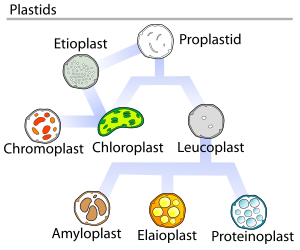Plastid
[2][3] Another primary endosymbiosis event occurred later, between 140 to 90 million years ago, in the photosynthetic plastids Paulinella amoeboids of the cyanobacteria genera Prochlorococcus and Synechococcus, or the "PS-clade".Plastids are sites for manufacturing and storing pigments and other important chemical compounds used by the cells of autotrophic eukaryotes.[8] In land plants, the plastids that contain chlorophyll can perform photosynthesis, thereby creating internal chemical energy from external sunlight energy while capturing carbon from Earth's atmosphere and furnishing the atmosphere with life-giving oxygen.Plant proplastids (undifferentiated plastids) may differentiate into several forms, depending upon which function they perform in the cell, (see top graphic).Extensive searches for plastid genes in both taxons yielded no results, but concluding that their plastomes are entirely missing is still disputed.Approximately 20% of angiosperms, including alfalfa (Medicago sativa), normally show biparental inheriting of plastids.[23] The DNA damage is due to oxidative environments created by photo-oxidative reactions and photosynthetic/ respiratory electron transfer.The primary endosymbiotic event of the Archaeplastida is hypothesized to have occurred around 1.5 billion years ago[26] and enabled eukaryotes to carry out oxygenic photosynthesis.The Apicomplexa, a phylum of obligate parasitic alveolates including the causative agents of malaria (Plasmodium spp.), toxoplasmosis (Toxoplasma gondii), and many other human or animal diseases also harbor a complex plastid (although this organelle has been lost in some apicomplexans, such as Cryptosporidium parvum, which causes cryptosporidiosis).The 'apicoplast' is no longer capable of photosynthesis, but is an essential organelle, and a promising target for antiparasitic drug development.


chloroplastsScientific classificationBacteriaCyanobacteriamembrane-bound organelleplantseukaryoticendosymbioticphotosynthesischromoplastsleucoplastsdifferentiateapicoplastsapicomplexaArchaeplastidaland plantsred algaegreen algaeglaucophytescyanobiontGloeomargaritaPaulinellaamoeboidsProchlorococcusSynechococcuskleptoplastyA. F. W. Schimpercircular chromosomeprokaryotic cellsautotrophiceukaryotesbiological pigmentsisoprenoidschlorophyllsunlight energyfatty acidsterpenesepidermal cellsplant cuticleepicuticular waxpalmitic acidmesophyll tissuestarchesproteinsmeristematicbinary fissionEtioplastsGerontoplastsplant senescencemonoterpenesAmyloplastsstarchgravityElaioplastsProteinoplastsproteinTannosomestanninspolyphenolsplastomerapidly dividing new cellsgenomeribonucleic acidstranscriptiontranslationNucleardifferentionmembranenucleoidsplant cellsstromulescytosolRafflesiaparasiticPolytomellataxonsbiosynthetic pathwaysRafflesiaceaehydrogenosomesprotistsglaucophytepeptidoglycancell wallfloridean starchLeucoplastApicoplasthornwortspyrenoidsangiospermsgametegymnospermspollenalfalfaphoto-oxidative reactionsphotosyntheticrespiratory electron transferrepairedDNA repairnuclear genomePhyscomitrella patensrhodoplastsmuroplastsphycobilisomeslight harvesting complexesstromathylakoidsendosymbiosiseukaryoteheterokontshaptophytescryptomonadsdinoflagellateseuglenidschlorarachniophytesobligate parasiticalveolatesmalariaPlasmodiumtoxoplasmosisToxoplasma gondiiCryptosporidium parvumcryptosporidiosistargetantiparasitic drugsea slugsElysia